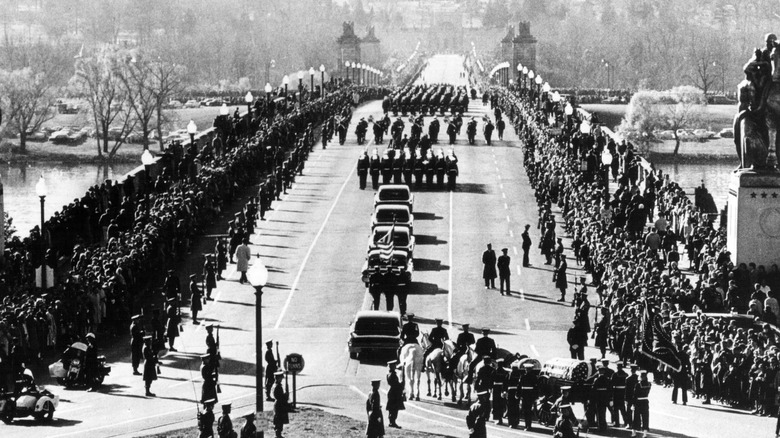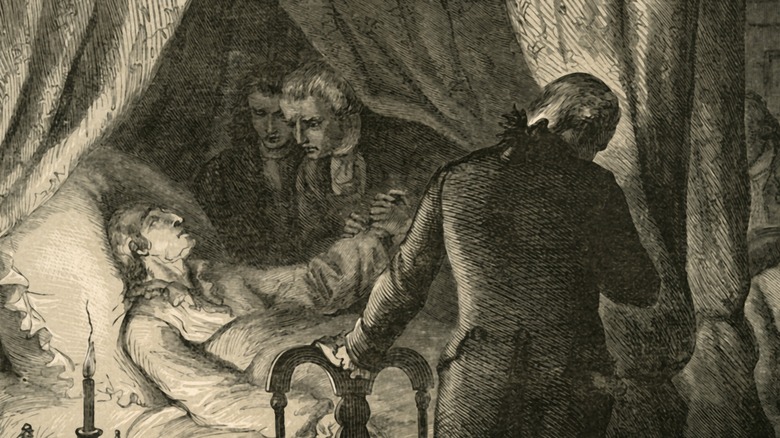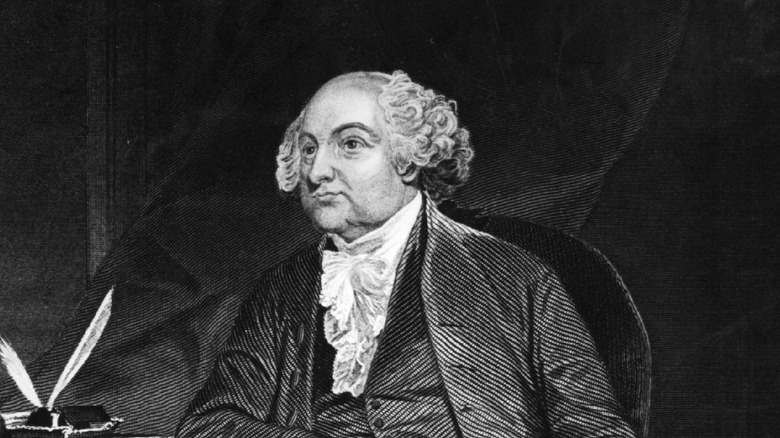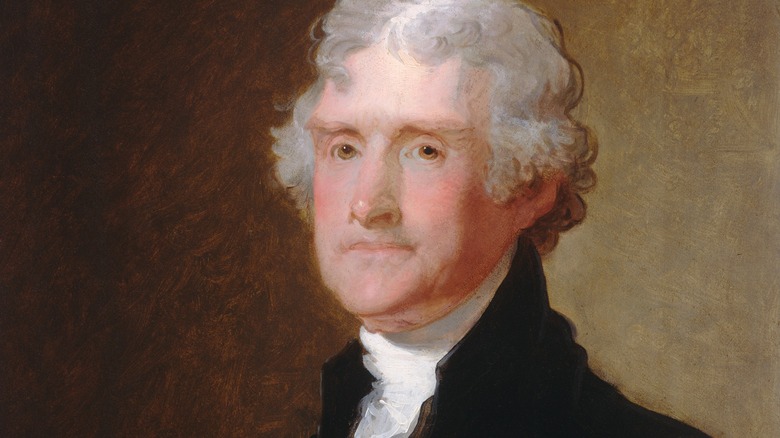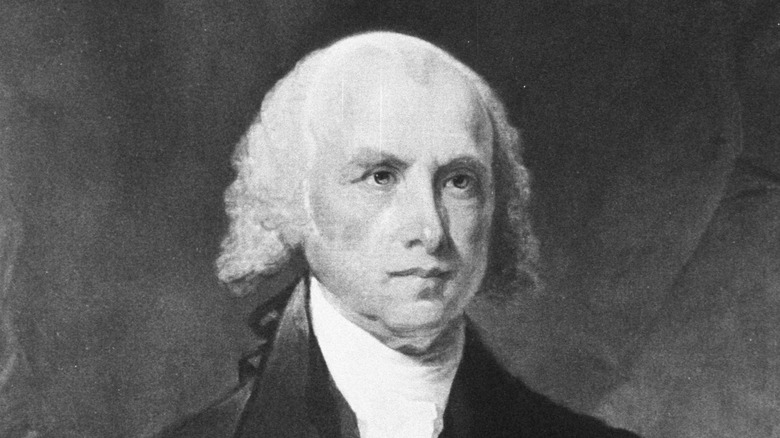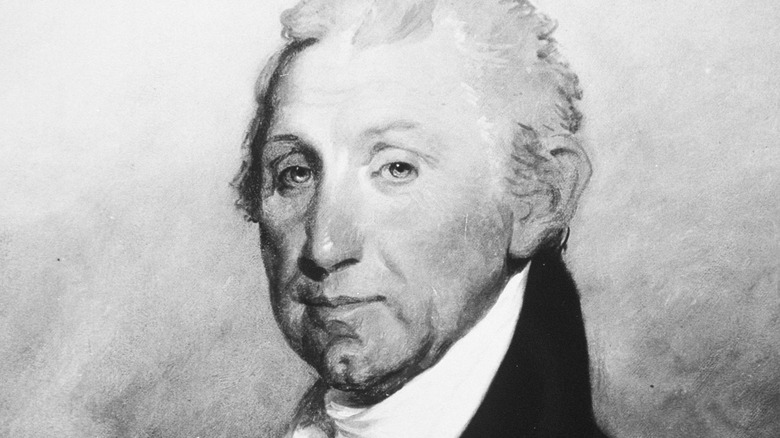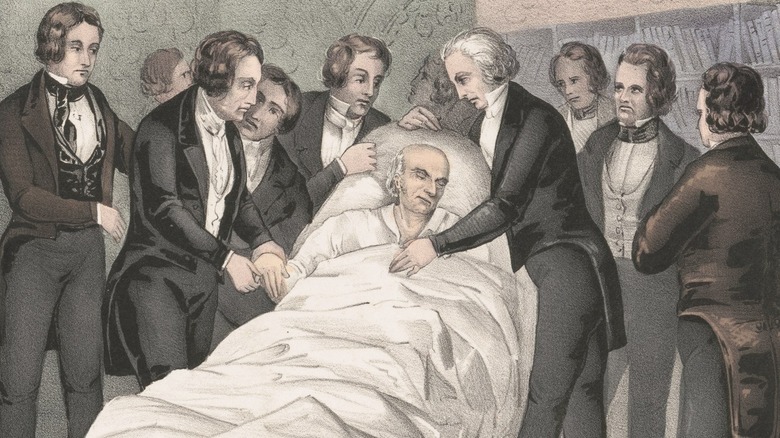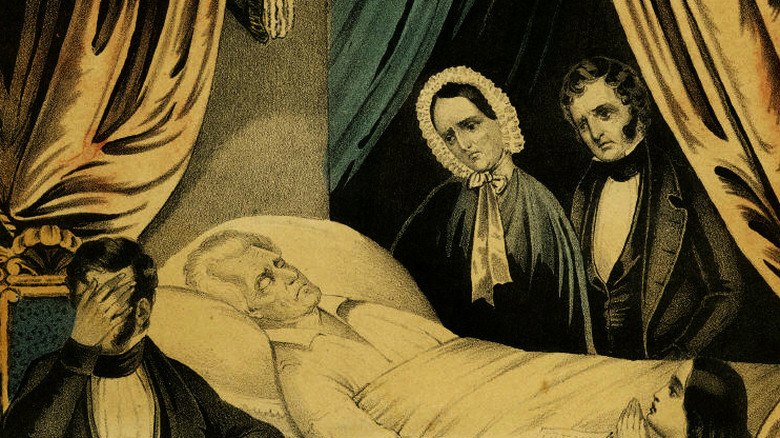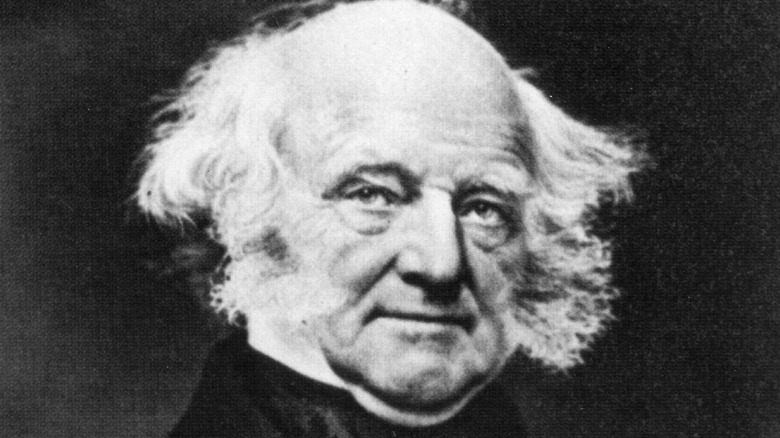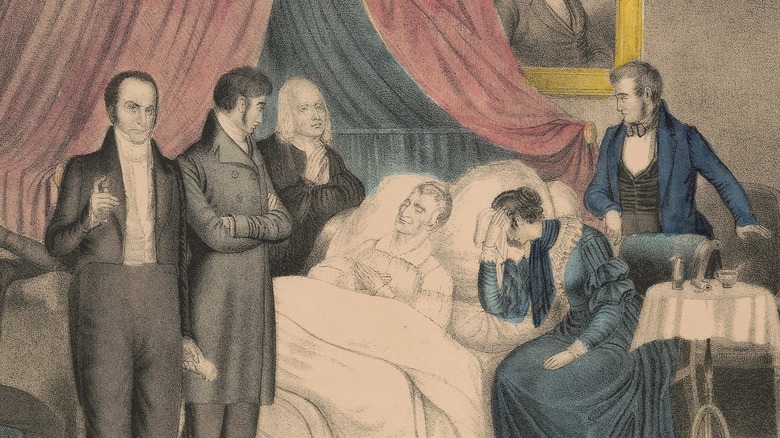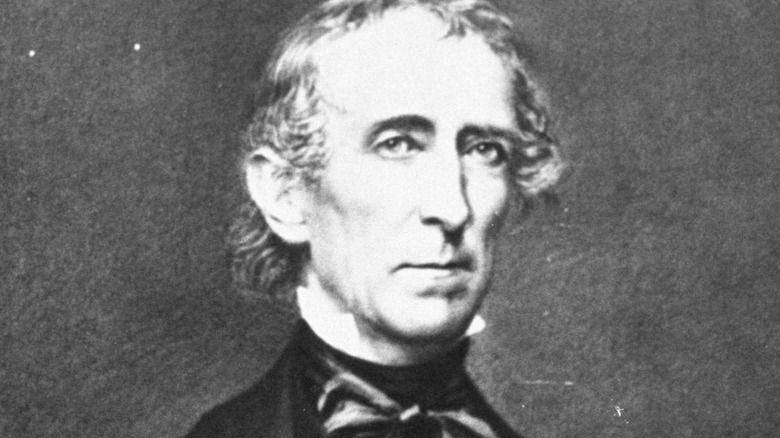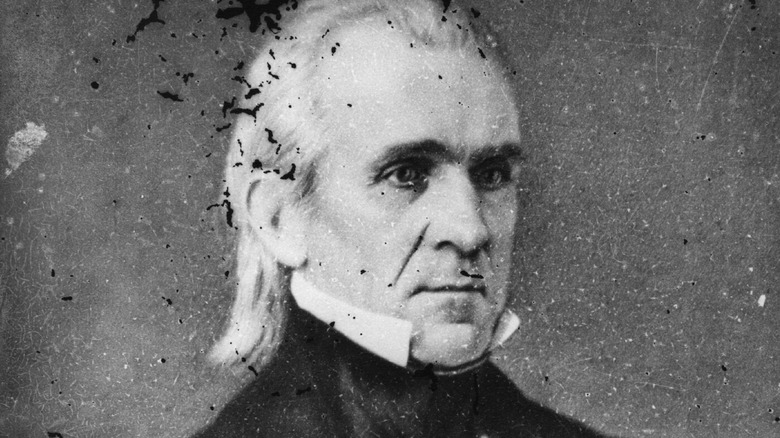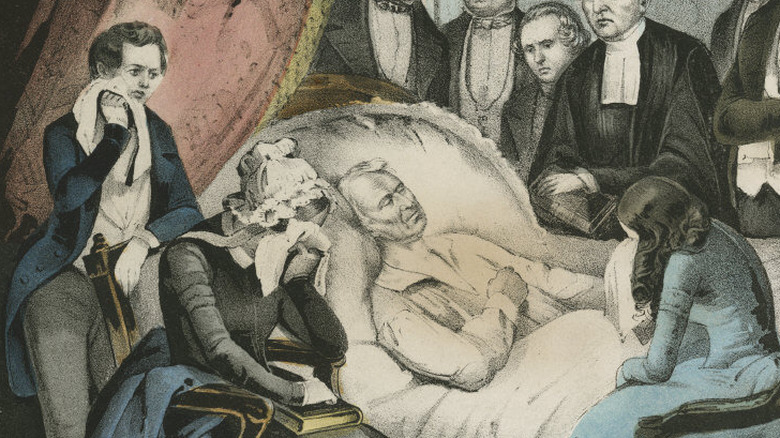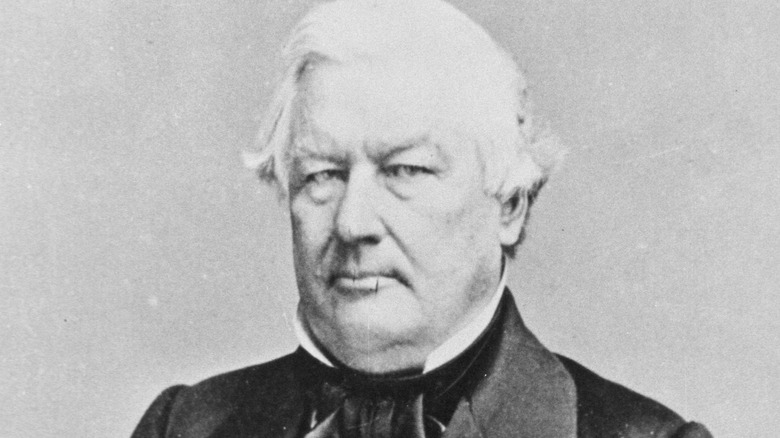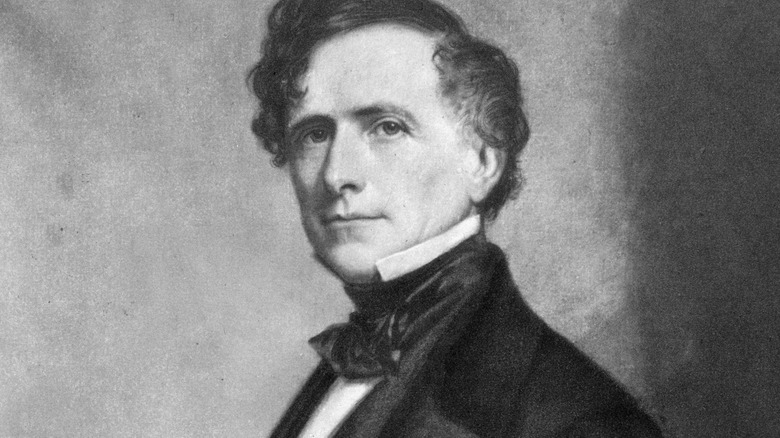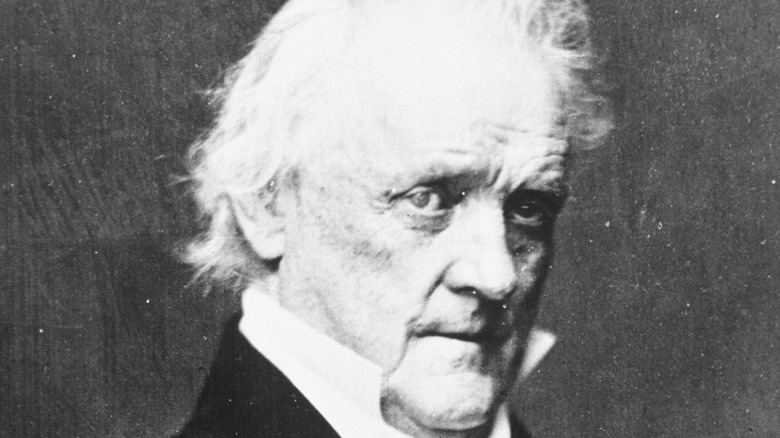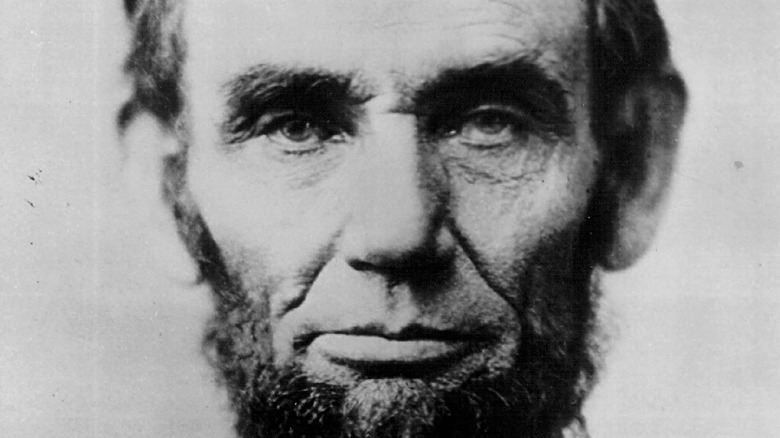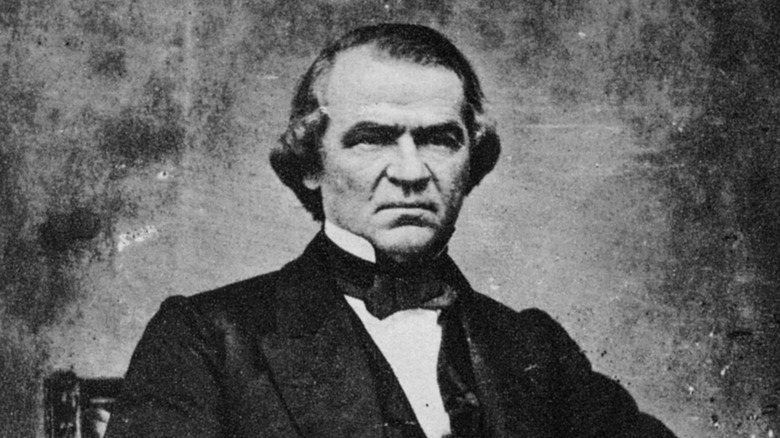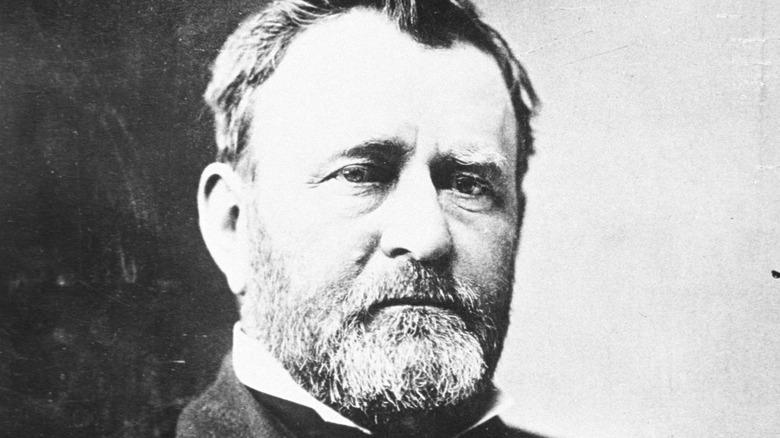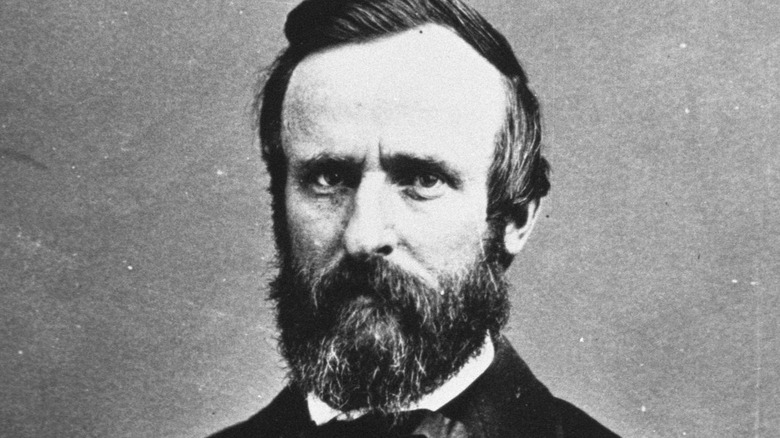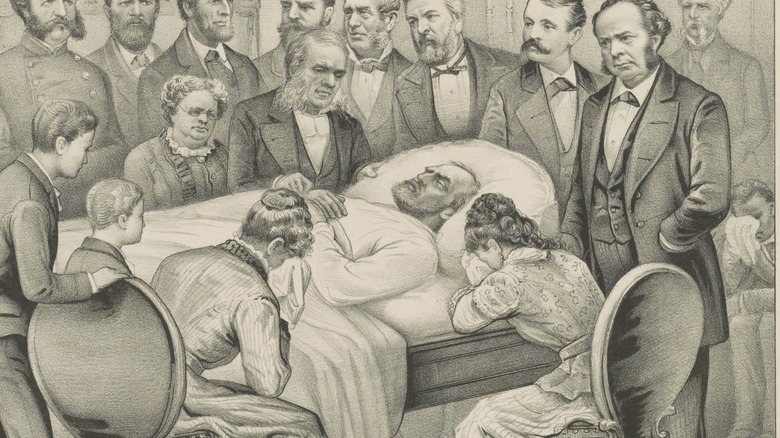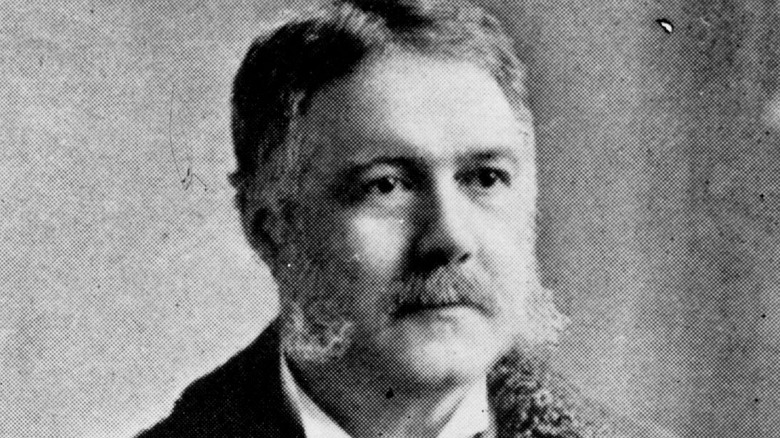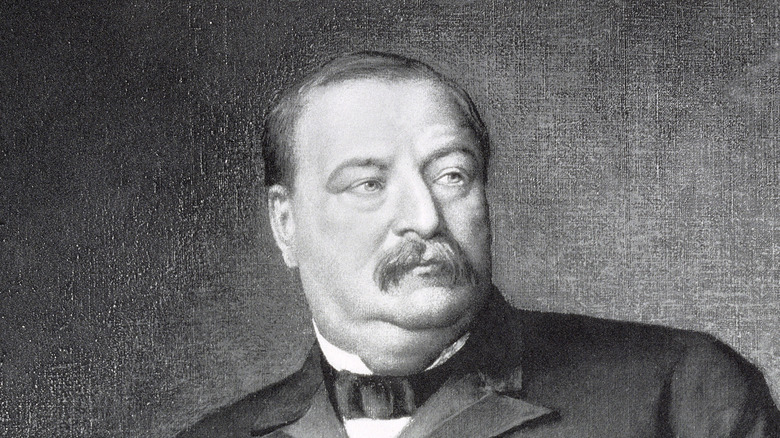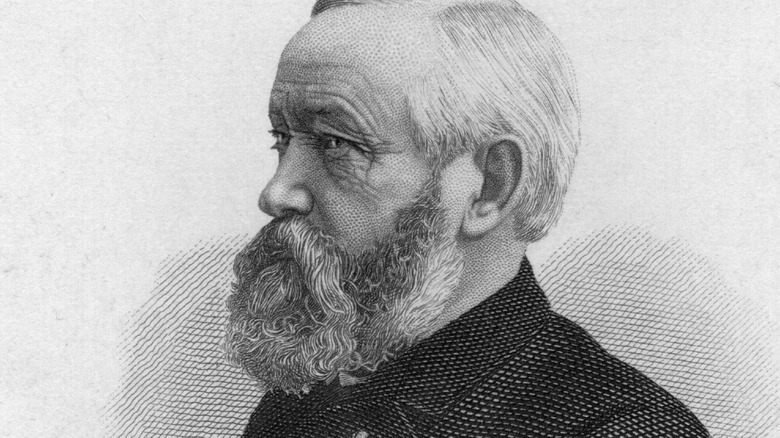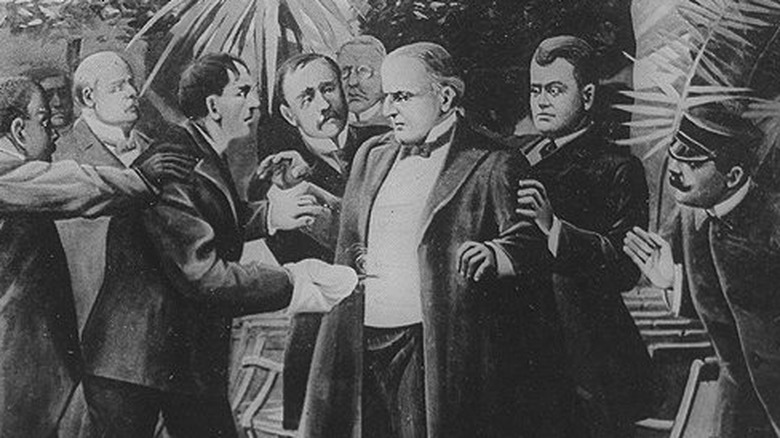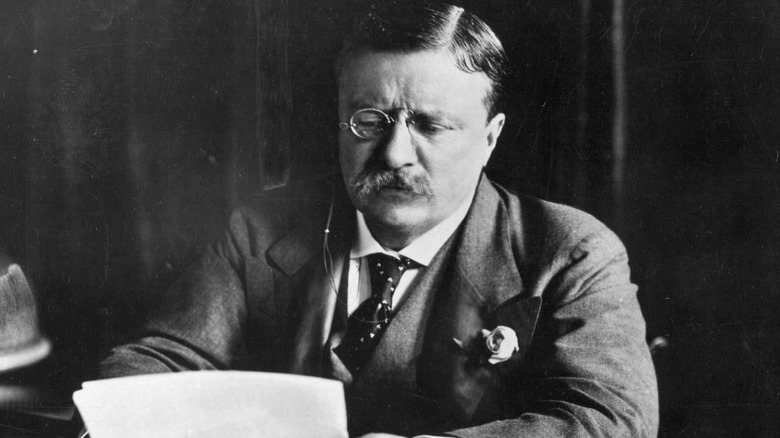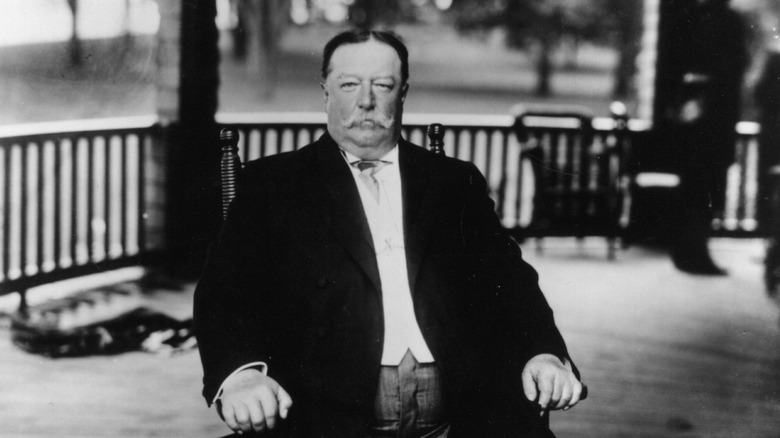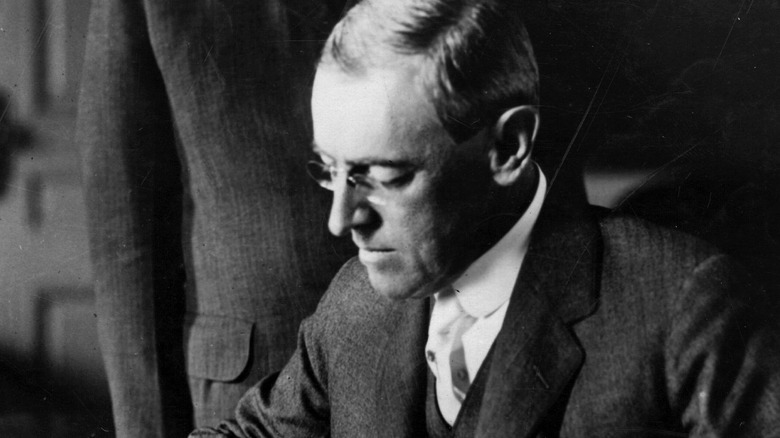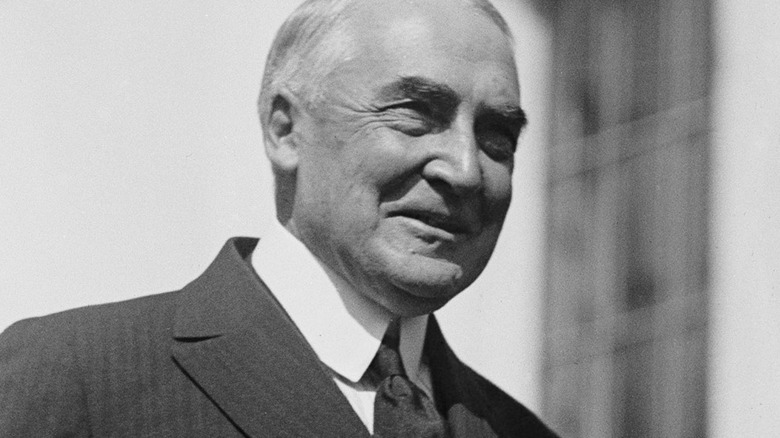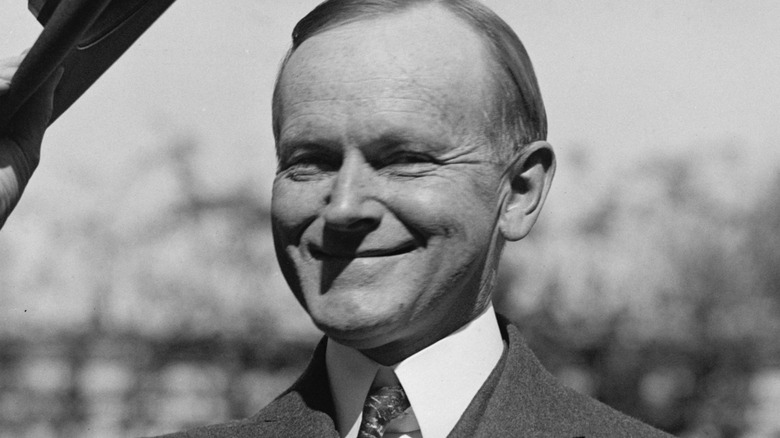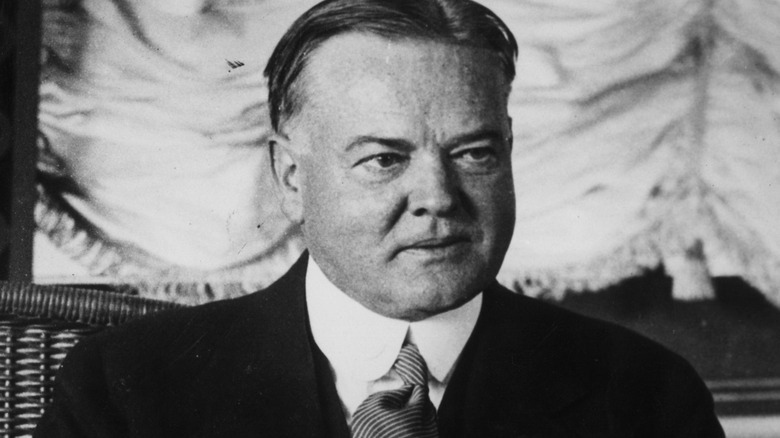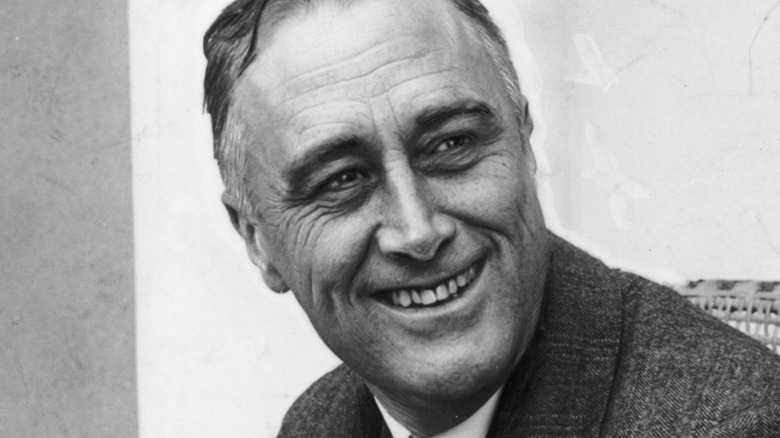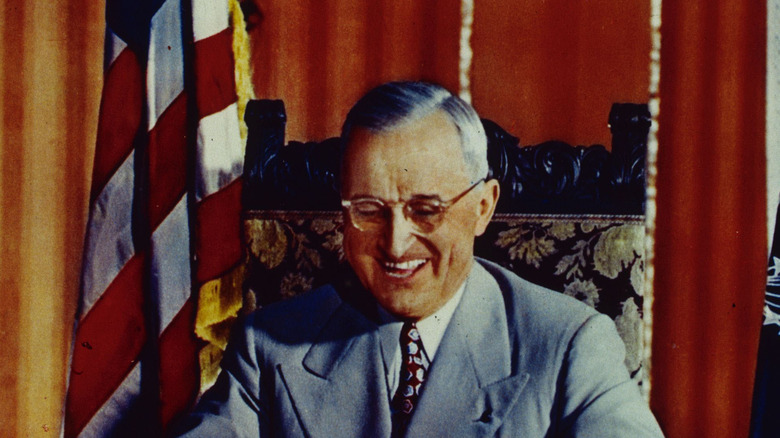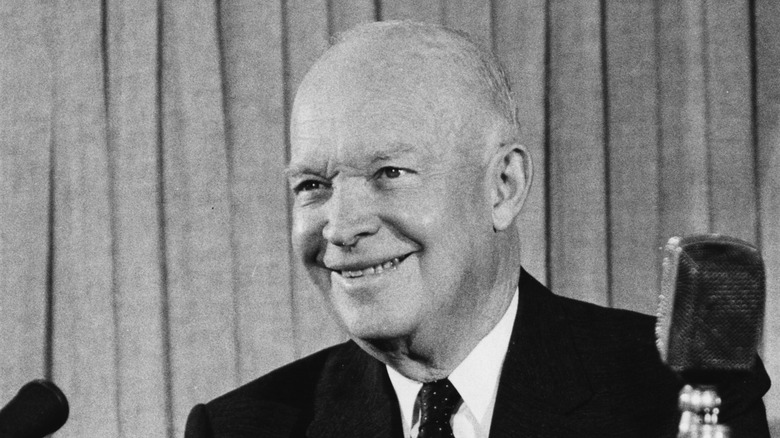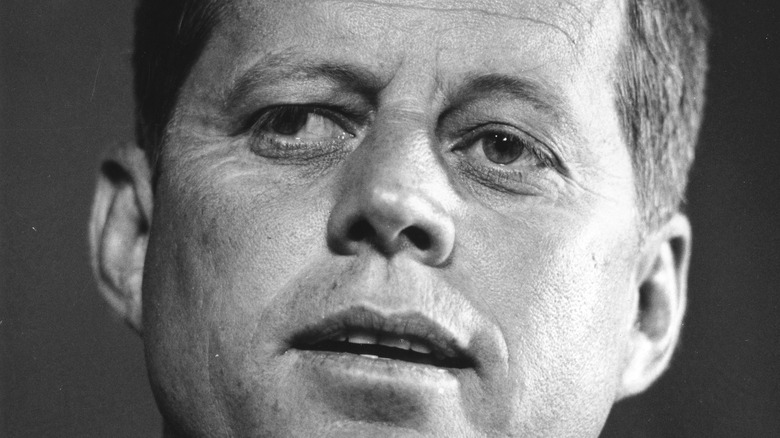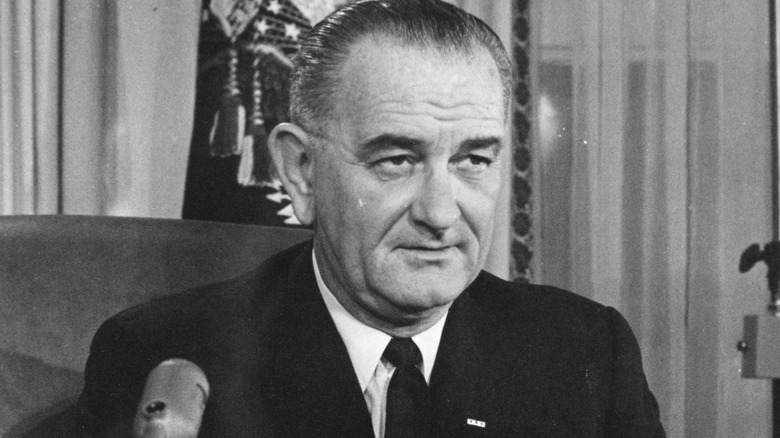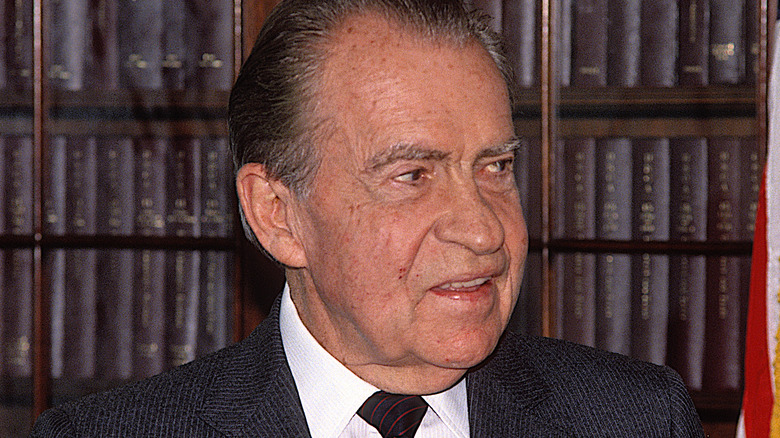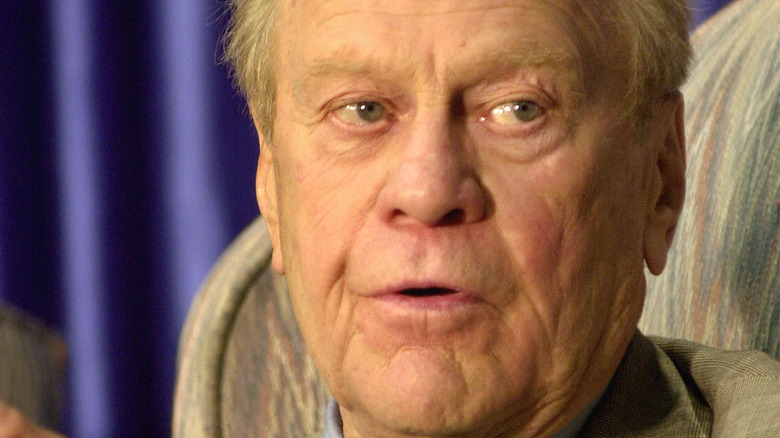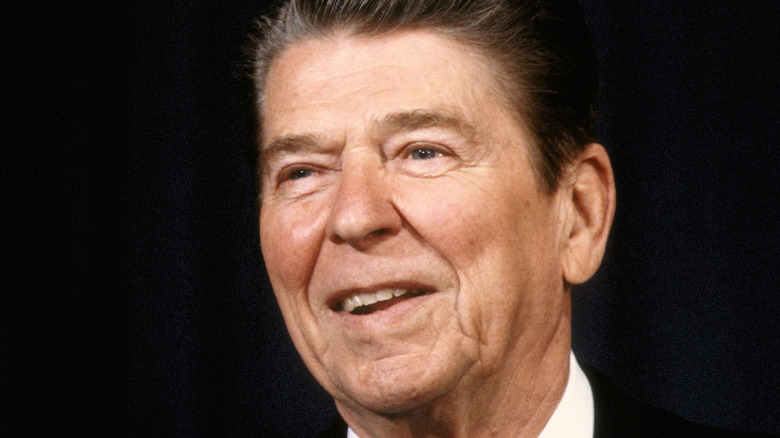How Each American President Died
In its nearly two-and-half-century history, the United States has had a number of presidents come and go. Most of these presidents are now obviously in the big white house in the sky, but exactly how they got there is not so commonly known. There are some exceptions: For example, there are the infamous assassinations of Abraham Lincoln and John F. Kennedy — and those who have a passing interest in historic factoids may know that William Henry Harrison died after just a month in office. Not the type of legacy he — or any other president — would want to be remembered for.
Yet, for the majority of presidents, most people don't know how they died. Some of the causes of death are predictable, such as cancer, old age, or heart disease. Other presidents died in painful, tragic, and horrible ways — and one drank a bad glass of iced buttermilk. So let's take a look at America's dead presidents and get into a few of the essentials of how each one expired.
George Washington
After leaving office in 1797, George Washington retired to his plantation in Mount Vernon, Virginia. In his last years, Washington had taken to supervising the farm from horseback. On December 12, 1799, while on such a ride, the former first president exposed himself first to light snow and then rain.
Washington, who was keeping to a tight schedule, refused to change his wet clothes. By the next morning, he was feeling unwell with a sore throat but decided to go out again despite the snowfall on the ground. This made his condition worse, and by the following day, he grew increasingly unwell.
By light, doctors were summoned who bled Washington and tried a variety of what would be called today at-home remedies, such as molasses, vinegar, and butter to treat the throat. His condition did not improve, and it is unlikely that the three other bleedings helped either. Washington died at age 67 with his family about him on December 14, 1799. The cause of his rapid death has been diagnosed as, according to the American Surgeon, "fulminant acute epiglottitis."
John Adams
John Adams was long-lived, reaching age 90, but suffered from heart disease that would eventually bring about his demise. "The President is Dead!" explains that Adams' health had been failing in 1826, but he seemed driven to reach Independence Day. This allowed time for well-wishers to visit him and arrange for fireworks and cannons to salute him on July 4.
On July 4, the former president awoke and heard the salutes. He said, "It's a great and glorious day!" However, by the afternoon, he started to slip off, with his last words being, "Thomas Jefferson survives." This was in reference to his old political rival Thomas Jefferson who defeated Adams for the presidency in 1800 but with whom he developed a friendship in later years. Yet unbeknownst to Adams, Jefferson had already died a few hours earlier.
Adams has the curious distinction of being the longest-living president, until the death of Ronald Reagan at age 93, some 178 years later.
Thomas Jefferson
Thomas Jefferson died on the same day as John Adams, on July 4, 1826, at his estate of Monticello in Virginia. Like Adams, Jefferson too was driven to live to Independence Day, although he had been suffering from a variety of health ailments for several years.
Jefferson's first troubles were rheumatism and septicemia, which were treated with a mercury ointment that probably poisoned him. He also had horrible bowel troubles as well as other ailments. Even so, the former president managed to make daily rides on horseback.
What seemed to do Jefferson in was that he began to retain water, which caused chronic pain, coupled with kidney disease and infections. It is also possible that Jefferson suffered from undiagnosed prostate cancer. All of this resulted in him becoming bedridden on June 26, 1826. By July 2, he was mainly incoherent and only roused himself one last time on July 4, before dying at about noon.
James Madison
James Madison, often credited as being the architect of the Constitution, served as president from 1809 to 1817, per Britannica. According to the Miller Center, Madison spent his remaining years tending to his plantations — which were worked by enslaved people — while also giving service on the Board of the University of Virginia, which he was also the head of.
In 1836, the former president's health took a bad turn. He suffered for months with chronic rheumatism and liver dysfunction, leading to his being confined to bed. Many in his family, as well as the country, realized Madison was dying, and hoped that he could make it to July 4. But it was not to be: Death quietly took him on June 28. According to "Immortal Last Words," Madison went to sleep for the last time, telling his niece, "I always talk better lying down."
He was buried the next day on his estate at Montpelier. In attendance were over 100 enslaved people, friends, and relatives. He was 85 years old.
James Monroe
James Monroe was the last of the Revolutionary War generation of presidents. He had always had dicey health: According to "The American Presidents: Washington to Tyler," in 1785, Monroe survived a bout of malaria picked up in the swamps of Mississippi, and would suffer from recurrences of the fever later in life.
After leaving the presidency in 1825, Monroe suffered a seizure. He recovered, but five years later started to develop lung ailments which may have been tuberculosis. Finally, he succumbed at 73 years, per Britannica, while visiting his daughter Maria in New York City on July 4, 1831. He was the third president to die on that historic date, and his services were held at Trinity Church in New York City. Apparently, Monroe had a last request that was largely unknown. The University of Mary Washington possesses documents that show that he desired to free his servant, the enslaved Peter Marx. This was apparently done posthumously and was the only enslaved person that Monroe ever legally freed.
Later, on the dead president's 100th birthday, his body was exhumed from New York and shipped to his native Virginia, where he was reinterred at the Hollywood Cemetery in Richmond.
John Quincy Adams
John Quincy Adams, the sixth president of the United States and the son of President John Adams, suffered one of the most dramatic of presidential deaths. After serving as president from 1825 to 1829, per Britannica, he decided to remain in public service. In 1831 he was elected to the House of Representatives.
According to the House of Representatives, on February 21, 1848, Adams had just finished a debate on whether to refer a resolution to the Committee of Military Affairs. This bill would have presented honorary swords to generals of the Mexican-American War, a war that Adams had viewed as being completely unjust. He voted no and returned to his desk on the House floor, where the 80-year-old man suddenly suffered a massive stroke.
Adams lingered for two days and was tended to at the Capitol. He finally expired on February 23. On February 26, a large funeral was held for the former president, attended by his political friends and foes, who all gushed praise for the statesman.
Andrew Jackson
Called "Old Hickory," Andrew Jackson had suffered through his life numerous wounds and, according to History, even fended off a would-be assassin with his cane in 1835. After leaving the presidency in 1837, he left behind a strong Democratic party, but also had health issues, per Britannica.
According to the book, "Grover Cleveland's Rubber Jaw and Other Unusual, Unexpected, Unbelievable but All-True Facts About America's Presidents," Jackson suffered from numerous maladies, including dropsy, chronic diarrhea, and tuberculosis. This all led to an unfortunate situation where "Old Hickory" retained lots of fluids. The biography "Andrew Jackson" emphasizes the point by quoting the president in his last days as saying, "I am a blubber of water." His condition was so bad by 1845 that doctors attempted surgery to drain fluids from his stomach, in his home at the Hermitage in Tennessee.
The operation was a failure, although Jackson lingered for some time. The family, in fact, was amazed to find that he lived through subsequent nights. However, he finally died on June 8, 1845, at age 78.
Martin Van Buren
Martin Van Buren, according to "The President is Dead!," enjoyed a long spell of good health after the end of his presidency in 1841, in the comfort of his Lindenwald estate in his hometown of Kinderhook, New York. This lasted until 1861, when he was struck by pneumonia, then the next July by bronchial asthma. His health declined so rapidly that on July 24, 1862, at 2:00 a.m., he died of heart failure. He was 79 years old.
The American Presidents: Washington to Tyler" explains that Van Buren was given an 81-carriage service, attended by the governor of New York and those local to Kinderhook who took his death hard. However, "The President is Dead!" points out that his death at the time was a bit of a footnote — undoubtedly due to the distraction of the American Civil War.
An interesting fact is that Van Buren, a single-term president himself, lived to see eight successive presidents in the years leading up to the Civil War, all of whom served one term, and with two dying in office.
William Henry Harrison
William Henry Harrison was elected the ninth president of the United States in 1840. At the time of his inauguration on March 4, 1841, he was 68 years old, which according to Britannica, made him the oldest president to assume office up to that time. He was also the last president who had been born during the colonial period, in 1773.
His Inauguration Day was a cold and drizzly day, and Harrison did not wear any protective gear as he delivered an epic nearly two-hour-long speech: The exposure to the elements developed into a cold. According to the book, "William Henry Harrison," the cold lingered for weeks, but the president did little to remedy himself. In fact, he continued to go about without an overcoat or hat — the cold morphed into pneumonia. By early April, he was confined to bed, and on the fourth day of that month, he died, the shortest presidency ever and the first president to die while in office.
There has been some questioning of Harrison's manner of death. Research published in "Clinical Infectious Diseases" (via History) asserts that because of the prolonged timeline, Harrison died of enteric fever brought about by contaminated drinking water.
John Tyler
By the time John Tyler died suddenly of a stroke in Richmond, Virginia, on January 18, 1862, he was an outcast. As an obituary in the New York Times reported, he alone of the former presidents shifted his loyalty to the Confederacy during the Civil War. In fact, according to Britannica, he had just been elected as a representative to the Confederate Congress.
Thus, it is no surprise when "John Tyler: The Accidental President" tells us that his funeral was a muted affair, to say the least. The ceremonies at the White House and elsewhere that would typically accompany a president's death were absent, as were any flags flying at half-mast in the North. The New York Times, in its obituary, labeled him a "traitor." This stigma, however, would only hang about the Tyler family's neck for about a decade.
After the war, he was generally forgiven, or at least his treason was ignored. In 1882, the federal government even gave his widow a $5,000-a-month pension, per Britannica.
James K. Polk
James K. Polk not only had the unhappy and painful fate of dying from cholera, but also of having a body that was seemingly never at rest. Polk retired after a single term in 1848, according to the Miller Center. Retirement did not suit Polk well since, in 1849, mere months after leaving office, he contracted cholera while touring New Orleans. He died on July 15, 1849, at his home in Nashville, Tennessee, at age 53.
Because Polk had died of cholera, his remains began a very unpresidential journey. The Washington Post reports that as per procedure with cholera cases at the time, it was dumped into a mass grave at the Nashville City Cemetery. This was presumably to contain the disease, but Polk's will was finally adhered to after a year had passed: Polk's family disinterred the remains and moved them to a plot at the Polk Place grounds, as the former president had originally stipulated.
The interment only lasted a few decades though, since in 1893, the family sold the property and Polk — along with his late wife — was dug up once more, and moved to the Tennessee capitol's grounds in a rather secluded spot. Once again, the former president was at rest, but in 2017, a push was made to exhume the body again. The intention was to move it again to his ancestors' home — where the Polk Museum is — in Columbia, Tennessee, in a grander tomb, though this effort failed.
Zachary Taylor
July 4, 1850, proved to be a hot holiday in Washington, D.C., but President Zachary Taylor, in attending to his presidential duties, needed to take part in the groundbreaking ceremonies for the Washington Monument. To stave off the heat, "The Forensic Historian" explains that after the ceremony, Taylor drank copious amounts of iced buttermilk, ate plenty of raw vegetables, and gobbled down some fresh cherries.
Shortly thereafter, History tells us that the 65-year-old president came down with a severe case of diarrhea. He became bedridden and died on July 9, 1850. The cause of death, in this case, was attributed to cholera, and one of the items Taylor consumed was most likely the culprit.
Nonetheless, there was some speculation that Taylor may have been poisoned by arsenic, since he was a forceful opponent of secession in the tumultuous years leading up to the Civil War. However, the Courier-Journal reported that forensic experts in 2014 exhumed and reexamined the body. It was concluded that it was not murder, since there were normal levels of potential toxins within the corpse.
Millard Fillmore
Millard Fillmore is one of America's forgotten presidents, though it could be said he has one of presidential history's more interesting names. After an unsuccessful run at being elected for his own term — having taken the helm after President Zachary Taylor died — and a second failed presidential campaign, he retired in 1856 to his mansion at Niagara Square in Buffalo, New York, per Britannica.
Two decades later, on February 13, 1874, The Buffalo News described how Fillmore suffered a stroke while shaving. While he managed to briefly recuperate, he was hit by a second stroke on February 26.
Now incapacitated, yet still lucid, the 74-year-old's time was soon up. On March 8, after receiving some soup to which Fillmore commented, "The nourishment is palatable," he died. If the rest of the country did not appreciate Fillmore — as president he promised to enforce the Fugitive Slave Act, making him very unpopular in the North — at least his native Buffalo did, honoring him with a long funeral procession that wound its way through the city. There were 25,000 Buffaloans who visited the coffin before he was buried in Forest Lawn Cemetery.
Franklin Pierce
Franklin Pierce was president in the years leading up to the U.S. Civil War, subsequently blamed for not effectively dealing with the sectional problems which led up to the conflict, and now largely forgotten, as described by the Miller Center. He was also a heavy drinker, which worsened after he left the presidency in 1857, and slipped into obscurity in his native New Hampshire. Apparently, his chronic alcoholism was made worse, according to "The President is Dead!," by the death of his three sons and wife due to various causes.
In July 1869, while at his cottage of Little Boar's Head in New Hampshire, the 64-year-old developed a swollen abdomen and was diagnosed with dropsy. He was confined to bed and lost so much weight that he slipped under 100 pounds. On October 7, after months of suffering, his friend's family stood on deathwatch: He expired in the early morning hours of the next day.
The final cause of death, as reported by "Presidents and Presidencies in American History," was cirrhosis of the liver. Pierce was buried at the Old North Cemetery in Concord, New Hampshire.
James Buchanan
James Buchanan is ranked by U.S. News and World Report as being the worst U.S. president in history, primarily for allowing slavery to spread and failing to prevent the secession of the Confederate states. To try to rehabilitate his reputation after his presidency, Buchanan published a book, called "Mr. Buchanan's Administration on the Eve of the Rebellion," telling his side of the story, which blamed the war on abolitionists and Republicans. However, the book was a flop, according to the Miller Center.
Buchanan had retired to seclusion in the last years of his life, at his home of Wheatland in Pennsylvania. According to "The Life of James Buchanan," the ex-president's health went into serious decline in 1868. The 77-year-old Buchanan repeatedly remarked that he was looking forward to death.
The Grim Reaper came for him on June 1, 1868, due to what was then diagnosed as rheumatic gout, but later sources such as "The President is Dead!" assert that Buchanan most likely died from pneumonia. He was buried in the Woodward Hill Cemetery in Lancaster, Pennsylvania.
Abraham Lincoln
On April 14, 1865, Abraham Lincoln was shot in the head by John Wilkes Booth at Ford's Theater in Washington, D.C. Although the details of the assassination are well-known, and as the National Parks Service relates, Lincoln's wound was quickly determined to be deadly, the fact is that immediately after the shooting, Lincoln was still alive.
The physicians who attended the dying president provided accounts of Lincoln's last hours, as described by the National Library of Medicine. The unconscious Lincoln was removed to the nearest bed possible, which was in a back room on the first floor of the Petersen Boarding House, just across the street from the theatre. He was laid down diagonally — since Lincoln was too tall for the bed frame — and stripped of his clothes.
Lincoln clung to life, despite his devastating injury, though his physicians were realistic about his prognosis. As recorded by the National Archives, one of the doctors, Dr. Robert King Stone, would later state, "I at once informed those around that the case was a hopeless one; that the President would die; that there was no positive limit to the duration of his life, that his vital tenacity was very strong, and he would resist as long as any man could, but that death certainly would soon close the scene." After an agonizing nine hours, Lincoln died at 7:22 a.m. on April 15, 1865, surrounded by his physicians, friends, and family.
Andrew Johnson
Lincoln's successor Andrew Johnson left the presidency in 1869, after a tumultuous term that included his impeachment. Johnson, however, staged a political comeback and, according to Britannica, was elected to the Senate in 1875. However, he spent hardly any time in the new position since his health, as noted in "Andrew Johnson: A Biographical Companion," was failing.
On July 28, 1875, Johnson visited his daughter in Elizabethton, Tennessee. According to "The President is Dead!," after dinner he went upstairs to rest and chat with his granddaughter Lillie. Suddenly, he fell off his chair: It was a stroke, one that partially paralyzed him and took away his ability to speak.
By the next day, his speech had somewhat recovered and he was able to move his right side again. However, recovery was not in the cards. Johnson was hit by a second stroke. The 66-year-old fell into a coma and died in the early morning hours of July 31. Obituaries were not kind to the disgraced ex-president.
Ulysses S. Grant
The post-presidential years of Ulysses S. Grant were tragic. According to Britannica, a few years after leaving office he was swindled by his investment partner, Ferdinand Ward, to such a degree that the family was impoverished. To begin to recoup the family fortunes, in 1884, the ex-president and Union general began to pen his memoirs. During this time, however, he also developed a terrible pain in his throat — which turned out to be terminal throat cancer.
Grant set off with gusto to complete his memoirs, while he was treated with cocaine and an extract of chloroform, working with his friend, Mark Twain. Grant's throat eventually became so swollen and painful that he could not eat.
It was clear that the only thing keeping Grant alive was the drive to write his memoirs. This was substantially completed by July 20, 1885. The 63-year-old wasted away until, by July 23, he cried out for water and died.
Rutherford B. Hayes
Upon leaving the presidency in 1881, Rutherford B. Hayes retired to his native Fremont, Ohio. There, according to the Miller Center, he worried about the growing gap between the wealthy and the poor, and remained active in civic life. Yet tragedy visited him within a few years. As described in "Who's Buried in Grant's Tomb?," Hayes was struck a heavy blow by the death of his beloved wife, Lucy, from several strokes in 1889. Hayes subsequently wrote: "The charm of life left me when Lucy died."
Hayes would follow his wife four years later, after contracting an illness on a drafty train. He used brandy to self-medicate and spent some time in bed, which improved his condition. However, on January 17, 1893, the 70-year-old was seized with a heart attack, and died in his son Webb's arms.
James Garfield
James Garfield had one of the most agonizing deaths of any president. It started on July 2, 1881, when, according to PBS, he was shot by Charles Guiteau. While the first bullet merely caught the president's shoulder, the second crashed through his vertebrae and into his gut.
Unfortunately for the 49-year-old Garfield, his treatment made matters worse. Physicians, in trying to remove the bullet, used unwashed hands to probe the wounds for the bullet, expanding the gash. In what must have been an agonizing procedure, they also did not use an anesthetic.
Because of these unhygienic methods, which were employed before germ theory was widely adopted, the wound became a cauldron of puss-filled sepsis. Fever, chills, and indescribable pain wracked the president as he wasted away from 210 to 130 pounds, while his organs stopped working. As his conditions worsened, the soon-to-be ex-president was shipped to his seaside cottage at Long Branch, New Jersey. Garfield met his end, crying in pain, on September 19 at 10:35 p.m.
Chester A. Arthur
Chester A. Arthur finished up Garfield's abbreviated term in 1885, but three years earlier, he had been diagnosed with Bright's disease, which affects the kidneys, and was at the time incurable. According to the Miller Center, the president kept this a secret.
Arthur allowed himself to be considered for the presidency in 1884 by the Republican party for a term in his own right, per Britannica. However, Arthur did not really promote himself as well as he might have, due to the knowledge that he had a fatal illness. He subsequently lost the nomination to James G. Blaine.
It was just as well that Arthur did not become president in his own right since he would never have finished a term. His health grew increasingly unstable, and his heart so weak that he could not even fish. According to the National Park Service, he died at age 57 at his home in New York City on November 18, 1886.
Grover Cleveland
Grover Cleveland is most known today for being the only president in American history to serve two non-consecutive terms. According to History, Cleveland left office at the end of his second term in 1897, refusing to run for a third term (term limits had not yet been established).
By 1908 Cleveland's health began to fail, which at its root, according to the Miller Center, was a gastrointestinal disease compounded by kidney and heart issues. According to one biography, "Grover Cleveland, the Man and the Statesman," it seems that he began to suffer increasingly worse episodes of illness. The ex-president, realizing that his days were growing short, had enough time to set his affairs in order.
On June 23, 1908, he had a massive heart attack which rendered him mostly unconscious, according to "The President is Dead." The 71-year-old died the next day, at his home in Princeton, New Jersey, with his wife at his side.
Benjamin Harrison
Benjamin Harrison, who first came to the presidency in 1889, was the grandson of the ill-fated ninth U.S. president, William Henry Harrison, and served as a Union general during the U.S. Civil War, according to Britannica. Unlike his grandfather, who died after only a month into his presidency (per Britannica), Benjamin Harrison managed to survive his term in office. He retired after losing the election of 1892 to Grover Cleveland.
Harrison retired from politics to Indianapolis, where he practiced law and still dabbled in public life. He married again at age 62 to his late first wife's niece and had a daughter. According to "The Library of American History," in 1901, he developed a raging cold that turned into pneumonia.
The illness grew so dire that by March 9, his case seemed hopeless, causing much anxiety throughout the nation. He slipped into unconsciousness and died on March 13 at age 67.
William McKinley
The third president to die by an assassin's bullet was William McKinley. The Miller Center tells us that on September 6, 1901, he was visiting Buffalo, New York, where he spoke at the Pan-American Exposition. At a reception that afternoon, in a part of the exposition called the Temple of Music, he was shot in the chest by the anarchist Leon F. Czolgosz, who used a .32 revolver that he had smuggled in.
While he was swiftly transported to a nearby hospital, the only doctor on hand was a gynecologist, according to History. Nevertheless, he underwent surgery which seemed successful, although the doctors could not locate the bullet.
McKinley seemed to be healing to the point where even his Vice President, Theodore Roosevelt, publicly predicted his recovery. However, it was not meant to be, and the 58-year-old McKinley took a turn for the worse: The president soon became infected internally with gangrene. This led to blood poisoning, which made his prospects bleak. He died on September 14, 1901.
Theodore Roosevelt
Theodore Roosevelt was known for his adventuresome spirit that embraced the outdoors and exploration. He was also a naturalist and conservationist at heart. This explains why, after a failed attempt at the presidency in the election of 1912, Roosevelt decided to go on an expedition to the Amazon River Basin, in Brazil, from 1913 to 1914.
History tells us that Roosevelt was excited about the adventure, quoting him as saying it was his "last chance to be a boy." However, this was no jaunty expedition, and the ex-president contracted malaria, becoming delirious with a high fever.
While Roosevelt did not die from malaria, the New York State Library asserts that it severely compromised his health. For example, in late 1918, he was hospitalized for inflammatory rheumatism. The 60-year-old died, rather unexpectedly, at his home of Sagamore Hill on Long Island, New York, as he slept on January 6, 1919.
William Howard Taft
After serving as president from 1909 to 1913, per Britannica, William Howard Taft was appointed the chief justice of the United States. There, according to the Miller Center, he served until his death on March 8, 1930.
Taft's historically struggled with maintaining a healthy weight. The Washington Post reported that at one point, while as president, his weight had risen to 332 pounds. According to "The President is Dead!," Taft had been having increasingly severe health episodes, such as high blood pressure, such that eventually, the 72-year-old formally retired from the court on February 3.
In his final days, Taft suffered from heart disease and other serious maladies. He would pass at home in Washington, D.C., with his nurse and wife by his side. Curiously, just five hours before Taft died, another Supreme Court Justice, Edward Terry Sandford, died. In addition, Taft's funeral procession was the first to be broadcast on radio.
Woodrow Wilson
At the end of the First World War, President Woodrow Wilson was under considerable stress in his efforts to promote the Treaty of Versailles and have the United States enter the League of Nations. This was undoubtedly contributory to the massive stroke which he suffered, according to History, on October 2, 1919. The damage done was considerable: The president suffered brain damage and partial paralysis, as described by PBS.
Remarkably, the White House managed to cover up the affair. It is said that the first lady, Edith Wilson, acted as a barrier between the president and curious eyes. Eventually, word got out in 1920, but even then, Wilson's illness was minimalized to the broader public. Britannica relates how after leaving office, Wilson managed to live for another three years at his home in Washington, D.C.
In the end, he recognized how frail he was, stating, "When the machinery is broken ... I am ready." Wilson died while sleeping at age 67 on February 3, 1924. A century later, Wilson remains the only president who has been buried in Washington, D.C.
Warren G. Harding
President Warren G. Harding died while in office of a sudden heart attack, during a tour of the country in 1923. The timing was significant, since innumerable scandals concerning his administration were about to break.
The tour, according to History, was called a "Voyage of Understanding": The president was trying to get a sense of the country, perhaps strategizing at running for a second term. The whirlwind tour took its toll on his health, and by the end of July, he began to suffer upper abdominal pain. At a speech on the 27th, Harding flubbed a speech in Alaska, calling the state "Nebraska," and needed to grasp his speaking lectern to keep himself balanced.
Doctors chalked Harding's ailment up to some bad seafood. However, it was becoming clear that Harding was having trouble with his heart. At the end of the month, his temperature spiked to a dangerous 102F. After being diagnosed with pneumonia, the tour was canceled. Harding's temperature normalized, however, by August 2. On this day, while in bed in a San Francisco hotel room, his wife was reading to him a flattering newspaper article about him, to which, according to "The Illustrious Life and Works of Warren G. Harding," he said, "That's good. Go on; read some more." He then suddenly died, instantly, of what was probably a cerebral hemorrhage. He was 57 years old when he died, per Britannica.
Calvin Coolidge
Calvin Coolidge was president of the United States during the heart of the 1920s, and the prosperity of the period led to him becoming highly popular. However, when his term ended in 1929, he chose not to run for office again. Instead, according to Britannica, he retired to Northampton, Massachusetts, where he took to writing.
Coolidge felt displaced in retirement. With the coming of the Great Depression, the federal government took unprecedented actions with the New Deal. Coolidge, who was about an offhand president as it was possible to be remarked in comments that were captured by the White House's website, "I feel I no longer fit in with these times."
However, Coolidge's quiet retirement was not destined to last long. The UPI reported that on January 5, 1933, Coolidge was struck by a sudden heart attack and died at age 60. According to "The President is Dead!," he was found by his wife, Grace, with arms akimbo on the bathroom floor. Doctors later declared that he had lain dead in his bathroom from between 15 minutes to 30 minutes before his discovery.
Herbert Hoover
Herbert Hoover lived long after his presidency ended in 1933. According to his obituary in the New York Times, Hoover spent decades in service to the nation, reforging a much-maligned reputation that had been tarnished because of the Great Depression. He was somewhat successful, too, so that by 1964 he was regarded as an elder statesman.
However, by the 60s, Hoover was growing quite ill. According to "More About the Presidents Than You Ever Wanted to Know," in his 80s, Hoover had grown almost completely deaf and blind, followed by intestinal cancer. By the end of his life, as described in "The Final Illness of Herbert Hoover," he had also developed cirrhosis and suffered from internal bleeding.
The ex-president spent his final days in a suite on the 31st floor of the Waldorf Towers, in New York City. As Hoover's health worsened, physicians did everything they could to prolong his life, such as giving him regular transfusions. Finally, at about 8:30 a.m. on October 20, 1964, the 90–year old Hoover fell into a coma with his two sons present. He died at 11:35 a.m. on the same day.
Franklin D. Roosevelt
In 1944, Franklin Delano Roosevelt won an unprecedented fourth term in office. However, his health was not faring so well. According to the Miller Center, not only did Roosevelt suffer from high blood pressure, but he also had heart and lung issues, including bronchitis. The following year saw the president's health decline at an alarming rate, and Roosevelt grew ever frailer.
However, most of the public was unaware of these health concerns. Thus, it came as a surprise when he died on April 12, 1945. At the time, Roosevelt was sitting for a portrait at Warm Springs, Georgia, a place that had served as a retreat for Roosevelt for decades. The 63-year-old complained of a headache, then collapsed — dead from a sudden cerebral hemorrhage.
Roosevelt's body was sent for burial at his home of Hyde Park, New York. As the late president made his final train ride to the North, hundreds of thousands of mourners gathered along the route to pay their last respects to the longest-serving president in U.S. history.
Harry S. Truman
After leaving the presidency in 1953, Harry Truman retired to Independence, Missouri, where he enjoyed good health until the mid-1960s, per Britannica. According to his obituary in The New York Times, in late 1972, Truman began to suffer from minor lung congestion. While he was initially treated at home, on December 5, his doctors sent him to Research Hospital and Medical Center in Kansas City, Missouri.
Unfortunately, the congestion could not be cleared, and his body struggled. Over the following weeks, his heartbeat grew more irregular, and, by December 6, Truman's condition had become critical: His temperature spiked to over 102 Fahrenheit, and his blood pressure dropped well below normal.
Truman fought and recovered somewhat, but his health again worsened toward the end of the month. Finally, just making it through Christmas, the 88-year-old ex-president died on December 26. The cause of death, according to the Miller Center, was simply "old age."
Dwight D. Eisenhower
Even while in office, Dwight Eisenhower suffered from heart problems. His first heart attack, according to "The Eisenhower Enigma," occurred on September 24, 1955, in Denver, Colorado. His White House biography reports that the president took seven weeks to recover. Despite the scare, Eisenhower was reelected to a second term in 1956.
After his time as president, Eisenhower's health issues were renewed. He suffered another heart attack in 1965 and then another in 1968. This third attack truly weakened the ex-president. According to the Miller Center, Eisenhower spent the last nine months of his life at the Walter Reed Army Hospital.
Apparently, even in the end, Eisenhower acted like the military leader that he was during World War II. When his fourth and fatal heart attack hit on March 28, 1969, the 78-year-old told the attendants to put him into a sitting position. He then ordered the doctors out of the room, leaving just his wife, son, and grandson behind. He took their hands and said, "I want to go; God take me," and died.
John F. Kennedy
The assassination of John Fitzgerald Kennedy in 1963 is one of the most famous and studied events in modern U.S. history. According to the JFK Library, on November 22, 1963, John F. Kennedy was in a motorcade in Dallas, seated in an open convertible, when he was shot in the neck and head and killed. The 46-year-old president slumped over his wife, Jacqueline, dead.
The assassination has been attributed to a lone gunman, Lee Harvey Oswald, who was himself killed on live television, two days after JFK's death. The Kennedy assassination has long been a favorite topic for conspiracy theorists: The conspiracies over who really shot JFK range from the Cubans to anti-Castro partisans to organized crime, per Britannica.
However, there does not seem to be much hope of any new revelations in the case, even after new documents started to be released by the National Archives in 2017. However, according to NPR, there are still some unreleased documents, as the event is still surrounded by issues that concern national security.
Lyndon B. Johnson
When Lyndon B. Johnson left the presidency in 1969, he was exhausted, not least because of the Vietnam War, which had dominated his presidency in the later years. Going into retirement, the Atlantic quotes him as saying, "I'm going to enjoy the time I got left."
However, Johnson seemed to have fallen into a neglectful attitude toward his long-term health. He gained an unhealthy amount of weight and took up cigarette smoking, something he had given up over fifteen years earlier, after a heart attack that nearly killed him. In April 1972, Johnson suffered another heart attack, which devastated his health. A wreck of a man, he spent the final months of his life exhausted and in pain.
He succumbed to a final heart attack at his ranch in Texas at age 64, on January 22, 1973. Somewhat ironically, according to the LBJ Library, he had learned the day prior that peace was imminent in Vietnam.
Richard M. Nixon
Richard Nixon is the only president to have resigned from the presidency in disgrace. After his resignation in 1974, he went into seclusion for a while, before making efforts to rehabilitate his image, per Britannica. To some extent, he was successful, but the stigma of scandal would haunt him for the rest of his life.
In 1993, his wife Pat died. Nixon's health was also in decline until April 1994, when the 81-year-old former president, as reported by The Washington Post, suddenly suffered a massive stroke before dinner at his home in Park Ridge, New Jersey. He was taken to the Cornell Medical Center in New York City, where at first he seemed to be alert, although partially paralyzed and unable to speak.
However, his condition worsened as brain swelling took hold. Finally, he fell into a coma and — because he had made it clear that he did not want to be put on a respirator — died on April 22, 1994, with his two daughters by him. Despite Nixon's reputation, he was nevertheless praised by the then-current president, Bill Clinton, as well as former presidents Ronald Reagan and George Bush.
Gerald R. Ford
After Gerald Ford took over the presidency in 1974, following Richard Nixon's resignation, he tried to win his own term in 1976. This effort failed, not least because Ford gave Nixon a controversial pardon — which was highly unpopular at the time. In 1977, Ford went into retirement, eventually living, as reported by NPR, in his home of Rancho Mirage, California.
Ford had generally good health after the presidency and reached his 90s, before he started to have any serious health issues. In 2006, he battled pneumonia and had treatments performed at the Mayo Clinic in Rochester, Minnesota, for a weakening heart, which included an angioplasty.
It was at his home that Ford died, at age 94, due to arteriosclerosis affecting the brain, as reported by Politico. Ford was given a state funeral, as described by the Miller Center, and laid to rest on the grounds of the Gerald R. Ford Museum in Grand Rapids, Michigan.
Ronald Reagan
After leaving office in 1989, Ronald Reagan retired to Bel Air, California. There, according to the Miller Center, he worked on his memoirs and led efforts to build his presidential library in Simi Valley. However, the health of the president fell into decline, primarily due to Alzheimer's disease.
In 1994, Reagan decided to make a public announcement about his illness. The Ronald Reagan Presidential Library and Museum maintains a copy of the public statement from him and his wife, Nancy, in which he wrote: "In opening our hearts, we hope this might promote greater awareness of this condition. Perhaps it will encourage a clearer understanding of the individuals and families who are affected by it." These sentiments not only drew attention to Alzheimer's, but also swelled funding into researching the disease.
CNN tells us that Reagan finally died at his home on June 5, 2004, at age 93. A state funeral was held that drew over 200,000 mourners.
George H.W. Bush
George H.W. Bush left office after one term, according to Britannica, in 1989 and promptly retired. Remaining active in voluntary activities, as well as his presidential library, the Miller Center explains that he split his time between their home in Houston, Texas, and Kennebunkport, Maine.
Bush had a long post-presidency, in which he fought various health issues, but what seemed to put fatal stress on him was the death of his wife, Barbara, in 2018. The Washington Post reported that Bush was hospitalized just one day after his late wife's funeral for blood infections. Bush was also, as told by The New York Times, battling Parkinson's disease, which had caused him to use a wheelchair.
Eight months after the death of Barbara, on November 30, 2018, he died in his Houston home.
